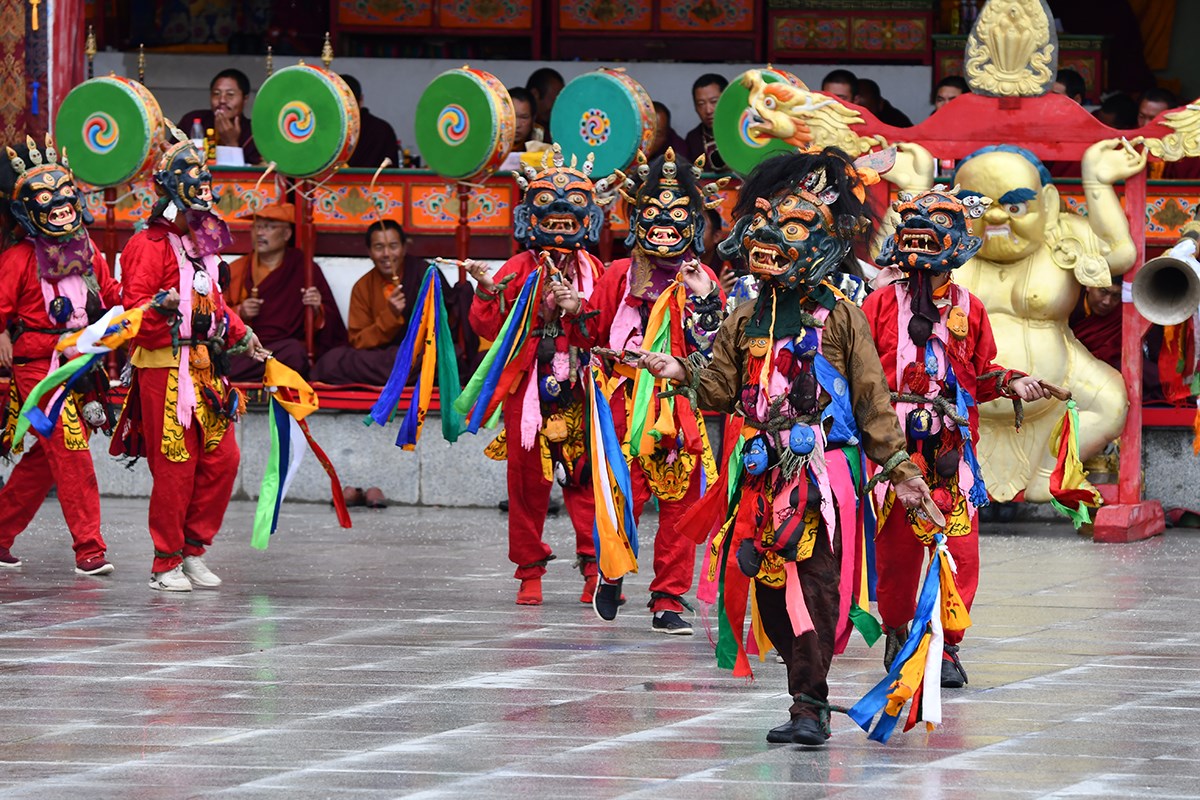Traditional Dances of Ladakh: A Vibrant Celebration of Ladakhi Culture


Ladakh, India’s mystical crown jewel, is known not only for its breathtaking landscapes and thrilling adventure opportunities but also for its rich cultural heritage. While Ladakh tour packages combine beauty, excitement, and serenity, they also serve as a gateway to the vibrant and distinct culture of Ladakh, a mash-up of music, dance, and celebration that is deeply embedded in the lives of its inhabitants.
Ladakh’s culture pulsates with rhythms and melodies that echo the region’s raw natural splendour. Ladakh’s music, whether soothing hymns sung in monasteries or jovial folk songs of local tribes, is a harmonious reflection of its unique socio-cultural identity. Traditional music, enhanced by instruments such as the Daman, Surna, and Piwang, creates a vivid auditory portrait of the high-altitude desert.
Ladakh’s culture would be incomplete without its lively traditional dances, just as the peaks dance to the tunes of the winds. These intoxicating blends of grace, energy, and joy tell the stories of the land, its gods, and its people. Every twirl, every step embodies centuries of tradition, providing an immersive experience into the soul of Ladakh.
Table of Contents

Kathok Chenmo is an integral part of the cultural heritage of Ladakh, echoing the area’s deep spiritual connections. It’s a revered mask dance drama performed in Ladakhi monasteries, steeped in centuries of Buddhist tradition. In this sacred spectacle, the monks, donning vibrant masks and costumes, depict the victory of good over evil.
The rhythmic dance steps, the captivating masks, and the solemn music create a mystical atmosphere that beautifully illustrates the culture of Ladakh. Kathok Chenmo serves not only as an artistic expression but also as a profound spiritual practice, enlightening spectators about Buddhist philosophy and values.

Kompa Tsum Tsag is an extraordinary cultural artefact that is an important part of Ladakh’s rich cultural heritage. This unique dance form celebrates Ladakh’s deep-rooted Buddhist ethos as a vibrant tapestry of the region’s artistic and spiritual traditions.
Dancers in complex patterns embody an intricate physical grammar of spirituality, representing various figures from Buddhist teachings. The dance is an important thread in the fabric of Ladakh culture, narrating ancient tales and doctrines.
Kompa Tsum Tsag’s colourful blend of music, movement, and meaning reflects the time-honoured values and philosophies deeply ingrained in Ladakh’s community.

In the realm of the culture of Ladakh, the Spao Dance holds a special place, reflecting a fascinating blend of artistry and spirituality. Often performed within the hallowed courtyards of monasteries in Leh Ladakh, this dance form is a thrilling spectacle that enacts the hunting and taming of the Ibex deer.
The dancers, in elaborate costumes, channel their inner spirits and portray the tale with vivid expressions and energetic movements. Each rhythmic pattern and gesture, synchronized with the pulsating beats, make the Spao Dance a symbolic thread, intertwining Ladakh’s socio-cultural fabric with its deep-rooted ecological consciousness.
Mentok Stanmo is a stunning depiction of the culture of Ladakh, a mesmerising dance performance that brings to life the region’s ancient lore and traditions. This dance, which has its origins in Ladakh’s agricultural practises, is typically performed by women during the flower festival to pay homage to the nature gods.
The performers, dressed in traditional Ladakhi attire, gracefully mimic flower blooming, reflecting the land’s harmonious relationship with nature. Mentok Stanmo, a cornerstone of Ladakh’s cultural heritage, embodies the region’s resilient spirit, close-knit community, and profound respect for the natural world.

The Leh Koshan dance is a vibrant representation of Ladakh’s cultural heritage, reflecting the region’s distinct tradition of storytelling through movement and rhythm. This collective dance form encapsulates the spirit of unity, joy and celebration inherent in the local community and is frequently performed during special occasions and festivals.
Dancers glide and weave gracefully together, their synchronised movements creating an enthralling visual spectacle. The Koshan dance is a true embodiment of Ladakh culture, with its colourful costumes, lively music, and intricate steps.
This dance provides a glimpse into the rich tapestry of traditions, emotions, and narratives that are woven into the social fabric of Ladakh.

Jabro is a vibrant folk dance form that originated in the enthralling landscapes of Ladakh and is primarily performed in the Changthang and Rong areas. Jabro, steeped in the region’s rich cultural tapestry, captivates audiences with its rhythmic patterns and joyful expressions. It is a delightful expression of togetherness and unity when performed at special occasions and community gatherings.
Dancers form a circle or line, hand in hand, swaying to the rhythmic beats of traditional Tibetan instruments in this communal dance form. The music is typically a delightful blend of soulful tunes from Rgya-Gling flute-like instruments and Damnyan percussive beats. The dance steps are quite simple, making Jabro an inclusive performance in which anyone, regardless of age or dance ability, can participate.

The Shandol Dance is a symbol of Ladakh’s vibrant culture, an energetic expression of its people’s joy and reverence. This folk dance, which is performed at the annual Shandol Festival, is a vibrant display of colour, rhythm, and communal harmony.
Dancers dressed in traditional Ladakhi attire step, sway, and twirl to the beat of folk music, mirroring the natural ebb and flow of the region. The Shandol Dance, steeped in tradition and laden with symbolism, serves as a pulsating heartbeat in Ladakh’s cultural landscape, encapsulating the spirit, stories, and shared experiences of the resilient Ladakhi community.

Nyopa, a Ladakhi folk dance, is a testament to the region’s diverse and rich cultural heritage. This dance form, which is typically performed during Losar, the Tibetan New Year, is distinguished by locals dressed in masks and vibrant costumes inspired by ancient folklore.
Dancers perform intricate sequences to the beat of traditional music, embodying spirits and deities in an enthralling fusion of artistry and tradition. Nyopa Dance is a vibrant expression of Ladakh’s customs, beliefs, and community spirit, and it plays an important role in the preservation and promotion of the region’s cultural heritage.

We are left with an indelible impression of a culture steeped in ancient traditions and spiritual richness as we conclude our journey through the rhythmic symphony of Ladakh’s traditional music and dance. Every Daman beat, every Nyopa dancer twirl, every mask in the Kathok Chenmo, and every step of Kompa Tsum-Tsag is a beautiful testament to Ladakh’s vibrant cultural heritage.
These traditions continue to live on in the grand theatre of the Himalayas, resonating through high mountain passes and valleys, captivating hearts, and transcending boundaries. To truly understand Ladakh, one must immerse oneself in its beautiful dance of life.
Ladakh’s culture, a harmonious blend of music, dance, and celebration, resonates with its breathtaking landscapes. From Kathok Chenmo’s spiritual grace to Nyopa’s vibrant folklore, Ladakh’s traditions embody its vibrant heritage. These dances are not just movements; they’re the heartbeats of Ladakh’s soul.
Sign up to receive our email, delivering the latest stories straight to your inbox.
